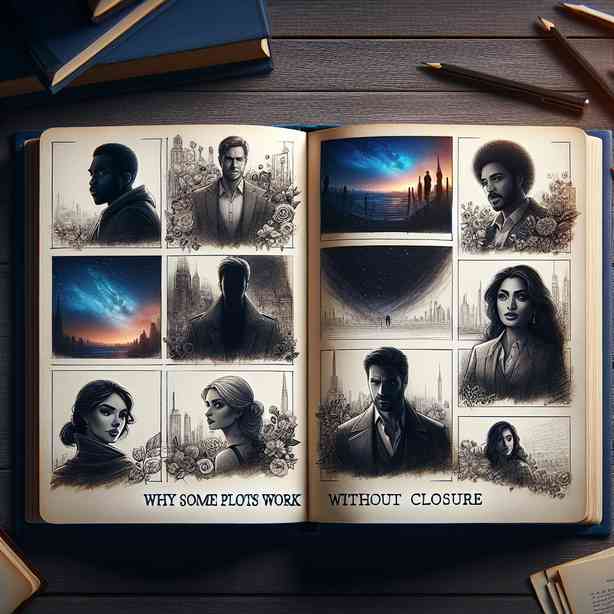
In narrative fiction, the concept of closure is often touted as a key component for crafting a satisfying story. The notion that every loose end should be neatly tied together and every character arc fully resolved seems to be a universal expectation. Yet, some plots emerge as powerful examples of the effectiveness of ambiguity and unresolved narratives. This article delves into why certain plots succeed without providing closure, exploring the underlying emotional resonances and thematic explorations that contribute to their impact.
At the heart of the matter lies the way humans perceive stories and the emotions they evoke. While resolution can provide comfort and a sense of safety, it’s the unanswered questions and lingering mysteries that often propel deeper engagement and contemplation. Viewers and readers are naturally curious beings, and narratives that leave space for imagination encourage active participation. When closure is absent, audiences cultivate their interpretations, connecting the dots using their personal experiences and emotions. This paradox of engagement illuminates why some stories flourish in ambiguity.
One of the compelling reasons some plots work well without closure is the emphasis on thematic exploration. Themes such as love, loss, and the human condition often benefit from a lack of resolution. By allowing these concepts to remain open-ended, creators invite audiences to reflect on their nuances. For instance, consider stories that tackle complex emotions associated with grief. A narrative that ends ambiguously can mirror the realities of loss, where closure is often elusive. Such endings evoke empathy, as they resonate with the audience’s own experiences and feelings of incompleteness.
Additionally, unresolved plots can amplify character depth. Complex characters often face internal struggles and conflicts that don’t necessarily reach a definitive conclusion. Characters who grapple with moral dilemmas or ethical quandaries can feel more authentic when their journeys remain unresolved. These narratives portray life’s inherent complexities and imperfections, encouraging audiences to reflect on their morality and decisions. When a story concludes without clear resolution, it opens up avenues for discussion and interpretation, prompting audiences to explore the characters’ motivations and choices more deeply.
Moreover, some plots thrive on the element of mystery. A narrative shrouded in intrigue can captivate audiences, drawing them into a web of questions that compel them to engage actively with the material. Think of stories that utilize cliffhangers or unexplained phenomena; these devices create suspense and anticipation. The thrill of not knowing what comes next can enhance the enjoyment of the narrative experience. By leaving certain elements unresolved, creators maintain a sense of urgency that keeps audiences engaged, and this engagement can be just as powerful—if not more so—than traditional closure.
Experiential storytelling often plays a significant role in plots that function without closure. Many stories aim to evoke certain feelings or sensations rather than provide a tightly wrapped narrative arc. These narratives prioritize the journey over the destination, immersing audiences in the emotions, visuals, and atmospheres of the story. Such an approach can create a profound connection between the audience and the narrative, fostering an experiential understanding that resonates beyond a linear storyline. In this context, closure becomes less important, as the emotional impact and the experiences crafted throughout the story take precedence over narrative resolution.
Delving into specific examples illustrates these concepts effectively. A prime example is the film “Inception,” which leaves audiences with a deliberately ambiguous ending. The spinning top, a key symbol of reality versus illusion, is left unresolved, prompting viewers to question the nature of dream and reality. This lack of conclusion encourages sustained discussion and theorizing among audiences, demonstrating how ambiguity allows the themes of perception and consciousness to resonate powerfully.
Another notable instance can be found in literary works, such as “The Road” by Cormac McCarthy, which leaves many questions about the future of its characters unresolved. The narrative’s bleak and desolate landscape mirrors the uncertainty of survival and the human experience. Readers are invited to ponder the implications of hope and despair, leading to a rich exploration of themes that don’t simply resolve in a neat package.
In television, series like “The Sopranos” have sparked intense discussions around their ambiguous endings. The final scene leaves viewers questioning the fate of Tony Soprano, inviting diverse interpretations influenced by personal beliefs and perspectives. This type of unresolved narrative promotes a collective dialogue among fans, creating a community around the contemplation of themes related to family, morality, and the human experience.
Ultimately, the effectiveness of plots that work without closure lies in their ability to engage audiences on multiple levels. They challenge traditional narratives, pushing boundaries and inviting deeper reflection. Whether through thematic exploration, character complexity, suspense, or experiential storytelling, these narratives demonstrate that ambiguity can evoke intense emotional responses and foster meaningful connections between the audience and the story.
In a landscape where instant gratification and clear resolutions are often sought after, narratives that resist closure can feel refreshing and provide a counter-narrative that reflects life’s inherent unpredictability. They encourage a shift from passive consumption to active engagement, empowering audiences to take part in the story-making process. As we continue to explore the world of storytelling, recognizing the power and purpose of unresolved narratives reminds us that ambiguity holds a unique place in the broader tapestry of narrative forms. In the end, some plots thrive without closure, challenging conventions and inviting us to delve deeper into the very essence of what it means to be human.


